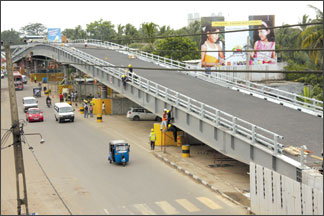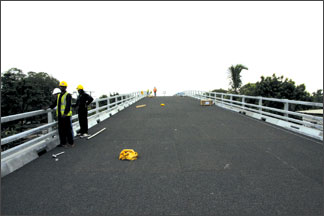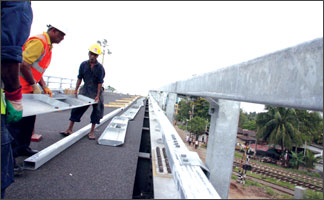Flying over
People fly over by the new overpass:
by Dhaneshi Yatawara
[email protected]
|

The new flyover at Kelaniya
|
|

President Mahinda Rajapaksa,Ministers and distinguished guests
at the opening ceremony. |
 |
|

Kelaniya flyover under construction |
 |
|
Pix by: Kavindra Perera |
No more traffic snarls at the Kelaniya railway crossing! Now the
vehicles vault over the railway tracks thanks to the new 315-metre long
flyover. The mega overbridge rises like a phoenix in the middle of the
road, scooping the vehicles from one side of the eternal bottle-neck to
the other.
At this spot the road remains closed virtually all the time, when
thousands of inbound and outbound vehicles try to beat the barrier which
opens and closes for about 150 times a day, for the trains to pass
through which agonizingly happens during peak hours.
According to the Ministry of Highways construction of two more
flyovers which have been earmarked will begin immediately. The work on
flyover at Panadura town will start tomorrow (31) and the other half of
the Kelaniya bridge by the end of April. Gemunu junction in Hendala will
follow suit.
Steel bridges
"Steel bridges are not alien to Sri Lanka. Fifty years ago we used
steel to construct bridges," said M. B. S. Fernando, Chairman of the
Road Development Authority. But the steel used those days were not
corrosion resistant and therefore as an alternative the construction
industry went in for pre-stressed concrete.
This ideal solution the concrete concept was embraced by all
construction industry. According to RDA Chairman Sri Lanka switched to
building bridges using concrete around 25-35 years ago. Since then the
steel technology improved surpassing the concrete technology and
currently it is steel that is being used for many construction purposes
all over.
"Today it is guaranteed that these advanced steel forms can last for
over 50 years, corrosion-free," Fernando added. Being able to finish a
construction work fast in double quick time was due to the significant
advantage of using steel, resulting in the Kelaniya Thorana junction
flyover being ready by 60 days. If concrete was used it may have taken
almost three years to finish the work.
"Worldwide, the construction industry has switched over from concrete
to steel. This is beneficial in so many ways," Fernando added.
Speaking to the 'Sunday Observer' , Engineer Iyantha Sirisena by
profession and the project manager, of the Access Engineering Ltd., said
the foundation of the bridge is concrete and the super structure, or the
upper part of the bridge is of steel.
Even the pillars are half concrete and half steel. "The unique
feature of the bridge is that it is a pre-fabricated structure. Which
means, the bridge was manufactured in sections at the British
construction company, Mabey and Johnson Co. Ltd., and later were
assembled on the site," he explained.
Access Engineering Ltd. is the local agent of Mabey and Johnson Co.
Ltd of United Kingdom. It was only the super structure that was
pre-fabricated; the foundation and sub structure was constructed by the
local contractor.
In concrete constructions the distance between the piers should be 30
feet whereas in steel bridges the distance can be expanded to 51 feet,
hence reducing the number of piers and hence cutting down the cost.
Water pipelines and telephone lines were buried deep underground and
bulky electrical lines transmission were carried overhead since the
bridge is located at a densely populated area within a major industrial
hub.
The relevant authorities had to shift the lines accordingly, making
room for construction, without disturbing the day-to-day activities of
the residents.Explaining further, Iyantha said the bridge has been built
to withstand earthquakes and other calamities, keeping in mind the
tsunami of 2004, which destroyed the coastal beet.
Long term investment
According to experts using steel for construction purposes is highly
beneficial due to fact that it is durable, cost-cutting and quicker
construction. So, far the construction world it is going to be steel
henceforth.
Under the current ongoing steel bridge project, 222 bridges are lined
up, including the four flyovers that are scheduled to be completed in
Kelaniya, Panadura and Hendala, in the immediate future. Out of the
balance, 32 bridges, in outstations that includes Galle, Hambantota,
Gampaha, Kalutara, Ampara, Matale, Nuwara Eliya, Ratnapura, Kegalle,
Badulla, Moneragala, Puttalam, Kurunegala and Anuradhapura.
The total cost estimated for the construction of all the 222 bridges,
including small structures, would be around 50 million sterling pounds.
"We have already received the aid from the Government of United Kingdom,
and we expect to get a further 75 million sterling pounds, in about a
month, for the next phase, when the Government plan to construct another
nineteen flyovers," Chairman Fernando said.
The reason for the lower cost in the first phase is that majority of
the bridges included are of small scale built in rural areas. Hence each
construction will costs only a small amount, compared to flyovers.
Cost factor
The oil price of sky-rocking to US$ 110 we, the ordinary people, can
not simple afford to burn gasoline at each and every traffic jam.
According to a survey done by the University of Moratuwa, a staggering
total of 12 billion rupees were being wasted in traffic starts per
annum. The indirect impact on the environment and on the pollution is
proving difficult to gauge.
So overall it is highly beneficial to adopt preventative measures to
rectify the situation.
The vision behind
To provide accessibility to all population in the country and to have
high and quality mobility road network for the transportation of the
passengers and goods. - Mahinda Chinthana : Vision for a new Sri Lanka.
According to the 'Mahinda Chinthana' , 20 flyovers have been planned to
be built in the Colombo metro and the suburbs to combat traffic jams.
Confirming the fact Highways and Road Development Minister Jeyaraj
Fernandopulle told the media after the grand opening of the Kelaniya
Flyover that the Government has planned to build flyovers in
Bambalapitiya, Rajagiriya, Negombo, Orugodawatta, Mahabage, Borella
Kanatte junction, Nugegoda, Panadura, Kohuwala, Attanagalle, Veyangoda,
Hendala, Mahawa and Nawalapitiya, within the next few years.
The Mahinda Chinthana - Ten year horizon development framework (2006
-2016) identifies that about 95% of the passengers and 98% of freight
are carried over the roads of national, provincial and local levels.
It also states that in addition to the official road network of is
91,862 km there are approximately 24,000 km of roads belonging to the
estates, state agencies such as forest, irrigation and wild life
departments, Mahaweli Authority etc.
Identifying the true value of improving the road access network
facility the Mahinda Chinthana ten year horizon development framework
(2006 - 2016) states: "Development of the road infrastructure
contributes to balance regional growth. Poor conditions of rural roads
has been identified as an important impediment to operation of
businesses and undertaking new investments in a recent study by the ADB
and the World Bank. Road improvements would also open up opportunities
for national integration, political and economical stability."
The flyover project is mainly funded by the British and Chinese aid
and a few will be built with our own resources, the RDA information
reveal.
We spend so much time on the road trying to get to work, go to the
bank or the market. It is an utter waste of time and energy, which have
a drastic effect on the country's economy. As we all believe the country
should move forward with every step we take. If our movements, our
actions do not directly or indirectly support the nation's forward
march, it is a hint to some missing factors.
World need changes at such points, be it minor or major. Our
solutions to the transport problem may not necessarily be complicated as
those of the developed nations. Yet, we need.
Hence, this 'flying' over concept may give wings to our development
process benefitting the future of our country. They target to finish
this project within four years. This would definitely be bridging the
gaps of development for the betterment of the people and their future of
our country. |
